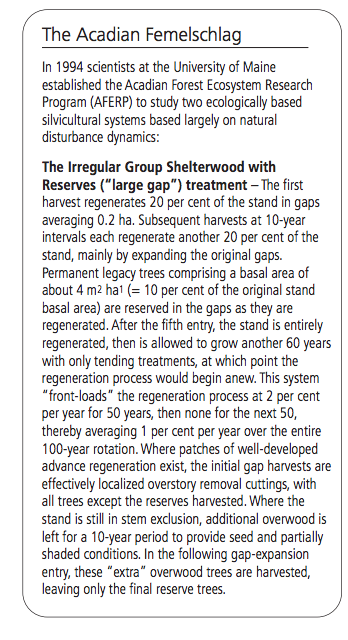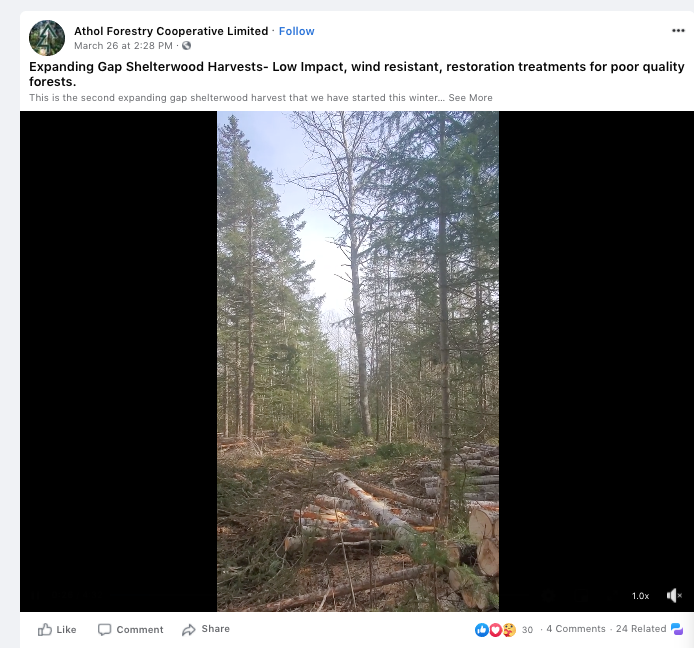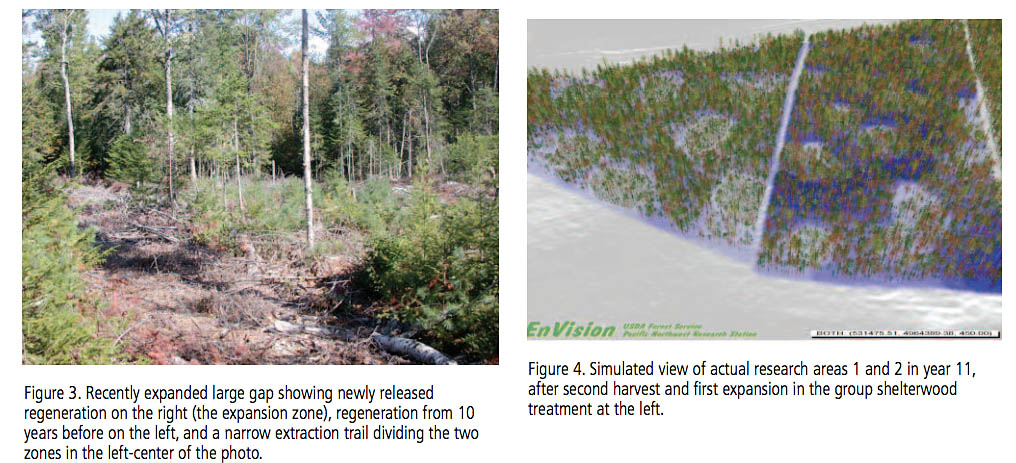Irregular Shelterwood silviculture figures prominently in the Independent Review as practices that should be adopted in NS. This emphasis reflects strongly the key role of Prof Bob Seymour of the University Maine in the Independent Review (also in the earlier Natural Resources Strategy – see below). View From Lahey for more background.
View Shelterwood on Wikipedia for an overview of Shelterwood systems, including Irregular Shelterwood. From Wikipedia:
|
View Nova Scotia Harvest Plan Map Viewer now specifies % retention 17Aug2019
Post on NSFN on August 17, 2019 by admin. Some concerns about the implementation (or lack of implementation) of Irregular Shelterwood systems in NS
Some Links On Irregular Shelterwood Silviculture
– Exploring Silvicultural Strategies in Northern New England – Irregular Shelterwood (Webinar, 63 min)
With Bob Seymour, April 25, 2017 “Irregular shelterwood silvicultural systems have been part of foresters’ silvicultural repertoire for well over a century, but only during the past two decades – as alternatives to clearcutting and ecological forestry have gained prominence — has this system been formally studied and applied in New England and adjacent Canada. This webinar will trace the origins of the irregular shelterwood system in Europe and North America and will define how this method is distinct from conventional shelterwood and balanced selection systems. The strong dependence of most northeastern species on large advance regeneration, coupled with myriad opportunities to conserve growing stock and enhance vertical structure, confer strong advantages of irregular shelterwood systems over both simpler and more complex silvicultural systems. Bob will illustrate these principles using several case studies of irregular shelterwood application from his 20+ years of research on the Acadian Femelschlag and recent treatments on his own woodlots.”
– The Irregular Shelterwood System:Review, Classification, and Potential Application to ForestsAffected by Partial Disturbances
P. Ramond et al.,Journal of Forestry• December 2009 “Structurally different from even-aged and balanced uneven-aged stands, irregular stands are an integralpart of forested landscapes in northeastern North America. The maintenance or restoration of irregularstand structure may be desirable, especially in areas under ecosystem-based management. This can beachieved at the stand level through the implementation of irregular shelterwood systems. The objectivesof this synthesis are to assemble the existing knowledge about the system, clarify the terminology inuse, and discuss its place in silviculture in northeastern North America. Irregular shelterwood iscompared with other regeneration methods and we propose a classification based on three variants. Thissilvicultural system is compatible with ecosystem-based management in forest types driven by partialstand mortality and gap dynamics and provides opportunities for maintaining old-growth forestattributes. However, it presents important challenges, especially with regards to planning, growth andyield prediction, and operational application
PDF available here
– Multi-Aged and Irregular Silviculture Methods
University of Kentucky, ppt slide set by Dr. John M. Lhotka
From the Natural Resources Strategy (2010)
From Restoring the Health of Nova Scotia’s Forests
(Bancroft and Crossland, 2010):
2.2 Age-class restoration
There has been a sharp decline since the 1950s in the percentage of provincial forests aged 61 years and older, resulting in a current dominance of young age classes. This points to unsustainable forest harvest levels, addressed in Section 2.3, Additional forest management strategies. Oldgrowth forests (greater than 101 years old) barely exist now, at approximately 0.3 per cent of the forest land base (DNR 2008). This is a grave concern, as some forestdwelling species are completely reliant on old-growth forest. It is paramount to prevent harvests of any remaining old-growth remnant forests. Biodiversity is safeguarded through restoring a significant portion of old forest stands and structures. The exact amounts should be guided by natural disturbance regimes.Restoring appropriate age-class diversity requires appropriate monitoring methods in order to measure success. Forest inventories currently do not accurately define multi-aged stands and classify mature forests as those that are 40-years old or more.
The dominant forest disturbance in Acadian forests was gap replacement, which resulted in uneven-aged stands. There are a variety of silvicultural systems that emulate gap replacement. Some are referenced in the recommendations. These systems all have in common small gaps that allow shade-tolerant species to establish and grow before the harvest. They also have legacy stands that ensure that other essential forest components requiring closed-canopy conditions and/or limited dispersal capacity can survive. A silvicultural system of particular interest is irregular group shelterwood. To obtain an enhanced portrayal of what forests may resemble under this new, ecologically based, multi-aged harvest system, see the Research Addendum available at www.gov.ns.ca/natr/strategy2010/, (Ecologically Based Multi-Aged Silviculture in the Acadian Forest, Robert S. Seymour, Figures 4-6).

From section 2.4 Ecologically Based Multi-Aged Silviculture in the Acadian Forest, by Robert Seymour, pp 39-43, in Research Addendum
From the Research Addendum Phase II, Natural Resources Strategy • April 2010
See Section 2.0 on Forests (Bancroft and Crossland) p. 8 to 44.
From the Recommendations, p. 12: “2) Create multi-aged stands using silvicultural systems that meet all ecosystem components at once. There are a variety of techniques that meet such criteria. Irregular shelterwood systems, particularly irregular group shelterwood and expanding gap systems, have been successfully implemented in Maine (Seymour 2010). Alternating strip cuts, or “Light Re-entry Silvicultural Harvesting,” as described in Salonius (2010) has been successful in New Brunswick. These systems all have in common small gaps that allow shade-tolerant species to establish and grow. They also have legacy areas that ensure that other essential forest components that require closed-canopy conditions and/or limited dispersal capacity survive. Direct consultations with Dr. Seymour could greatly assist the implementation process in Nova Scotia.”
Prof Seymour contributed section 2.4 Ecologically Based Multi-Aged Silviculture in the Acadian Forest, pp 39-44 which includes some informative boxes (e.g. as above at left) and photos.
Related
– Forest structure following tornado damage and salvage logging in northern Maine, USA
Shawn Fraver et al., 2017. Canadian Journal of Forest Research 47(4): 560-564 “Understanding forest structural changes resulting from postdisturbance management practices such as salvage logging is critical for predicting forest recovery and developing appropriate management strategies. In 2013, a tornado and subsequent salvage operations in northern Maine, USA, created three conditions (i.e., treatments) with contrasting forest structure: blowdown, blowdown + salvage, and control (undisturbed). We sampled forest structure in five stands representing each of these three treatments. Our results document obvious and predictable changes to forest structure caused by the blowdown and salvage operations; however, they also include unexpected findings: downed coarse woody debris volume remained quite high in the salvaged areas, although its vertical distribution was markedly reduced; salvage operations did not reduce fine woody debris volume; and the salvage operation itself reduced the abundance of upturned root masses. Our study contributes to a growing body of literature highlighting the fact that outcomes of salvage operations vary considerably from situation to situation. Nevertheless, they suggest that salvage logging has important implications for residual stand structure and regeneration potential and that these implications should be considered carefully when weighing postdisturbance management options.” Keywords: fire risk, fuel loads, pit-and-mound, Picea rubens, wind disturbance, woody debris.” (One of the co-authors is Bob Seymour)
Ecological Forestry: Days 2-4 (Maine Public Lands 1)
On Family Forests (facebook Group). “Maine’s 600,000 acres of public land have been managed for more than 30 years to produce older, larger, and more diverse stands of trees native to the Acadian Forest. Dr. Robert Seymour (in red), professor emeritus of forestry at the University of Maine, has been a member of the silvicultural advisory committee for state-owned woodlands since 1986. Retired forester George Ritz (in green) managed about 80,000 acres of public lands during that same period. In today’s clip, Seymour talks about implementing ecological forestry on Maine’s public lands. William Lahey’s “Independent Review of Forest Practices in Nova Scotia,” released in August 2018, recommended that Nova Scotia also embrace this approach to forest management. Our first question: What is ecological forestry?
Forest structure more important than topography in determining windthrow during Hurricane Juan in Canada’s Acadian Forest
Anthony R.Taylor et al., 2019. Forest Ecology and Management Volume 434, 28 February 2019, Pages 255-263
Wind is an important driver of forest dynamics in eastern Canada, but knowledge of variables that predispose forest stands to windthrow remains unclear. This is of particular concern as climate change is expected to alter the frequency of strong wind events that affect eastern Canada. In this study, we used widescale forest survey data from Nova Scotia, Canada, of wind damage caused by Hurricane Juan, to investigate variables that influence stand vulnerability to windthrow. Juan made landfall as a category SS2 hurricane with sustained winds of 158 km/h and damaged over 600,000 ha of forest. The damage zone was surveyed using aerial photography and satellite imagery, delineated according to level of wind damage, and digitized as a 15 × 15 m resolution spatial raster layer. We selected a random sample of 50,000 cells classified as intact forest and 50,000 cells classified as stand-replacing windthrow from the raster layer and used boosted regression tree analysis to explore the influence of various meteorological, topographic, soil, and forest structural variables on the occurrence of windthrow. Wind speed and forest structure, specifically stand height and species composition, were most influential in determining windthrow. Sustained winds of at least 95 km/h or gusts of 130 km/h caused >50% probability of windthrow. Taller stands were most vulnerable, especially those dominated by spruce (Picea spp.) and balsam fir (Abies balsamea), whereas higher hardwood and pine abundance reduced windthrow. Interestingly, topographical exposure (Topex) ranked low in overall influence; however, a clear relationship between increased exposure and windthrow was observed. Contrary to expectations, mesic soils were most vulnerable to windthrow
Challenges facing gap-based silviculture and possible solutions for mesic northern forests in North America
Christel C. Kern et al., 2017 Forestry 90, 4–17. Useful review of concepts. Under Moving Forward in Practice> Experiment and revisit old and untested ideas
Forest ecosystems and operational conditions change over time. Consequently, forest management may best be viewed as an open-ended experiment. As such, consistent terminology, documentation and monitoring of outcomes are needed to advance our understanding of contemporary system dynamics and adapt and codify new techniques. Furthermore, given the rapid pace of change, adaptive management approaches that integrate research and monitoring are needed to respond in real time to changes on the ground.
A recent example of experimenting and revisiting old and untested ideas is the ‘expanding gap’ or Acadian Femelschlag approach tested in Maine, US (Seymour, 2005), which includes a hybrid of irregular shelterwood harvesting and group selection, retaining legacy trees permanently within group openings that are expanded at each harvest entry. This emulates both gap expansion processes and the biological legacies seen in winddisturbed forests. Practiced as an area-based prescription on a 100-year rotation, it is only through permanent retention within expanding gaps that trees >100 years of age are maintained within the stand as a whole (Seymour, 2005; North and Keeton, 2008). Continued monitoring will develop and adapt the system with changing forest conditions.

Expanding Gap Shelterwood Harvests- Low Impact, wind resistant, restoration treatments for poor quality forests.
Athol Forestry Cooperative Limited
More videos here
DGP Question: It looks exemplary. As I understand it, this is a type of harvesting Seymour/Lahey want to see a lot more of in NS. How difficult is it to do, does it require or is more readily performed with smaller equipment, is it likely to be widely adopted in Nova Scotia on Private lands under existing market conditions; is any of it being conducted now on Crown lands that you know of? I have read that it is a technique that ” Practiced as an area-based prescription on a 100-year rotation, it is only through permanent retention within expanding gaps that trees >100 years of age are maintained within the stand as a whole” – so it seems appropriate also for stands patches of older trees. Any comment?
Craig Tupper
Ans: Haha! Love the questions David! This is actually inspired by work I saw in Maine with Bob, George Ritz, and Jessica Lahey with NSWOOA two years ago. It’s not that difficult to do operationally. It certainly takes more planning and careful layout than even a single tree selection harvest. The great thing is that it can be done with anything from a large tracked harvester, down to smaller scale equipment depending more on tree size. This one was completed with a mid sized wheeled John Deere 1170 which was perfect for the white birch, red maple and smaller trembling aspen. It struggled to control some of the larger aspen though, which comes into play when trying to protect advanced regeneration. Some considerations with this type of harvest is that it generates small amounts of volume vs the overall area treated, so this site was combined with an adjacent 40% removal commercial thinning to make it viable for the contractor. The first site we started this winter was in larger aspen and red maple and had a road right of way included to make the volume viable for the contractor. As you can imagine, this generates a majority of low quality, low value product and would not have been possible without our partnership with the Dalhousie Agriculture campus and their biomass facility. As you’ve said, the key to developing old forest structure in these areas is retaining long lived tolerant and mid tolerant trees within these gaps. On this site we chose each gap based on the presence of good quality advanced regeneration and pole sized to mature tolerant species being present near to a preplanned location from an ArcGIS excercise. This treatment could be used in older stands, potentially more wind-prone stands to maintain continuous cover and an uneven aged condition over time. As for crown lands, I am unaware of this method having been used at this time, but that would be a better question for DLF. Thanks

